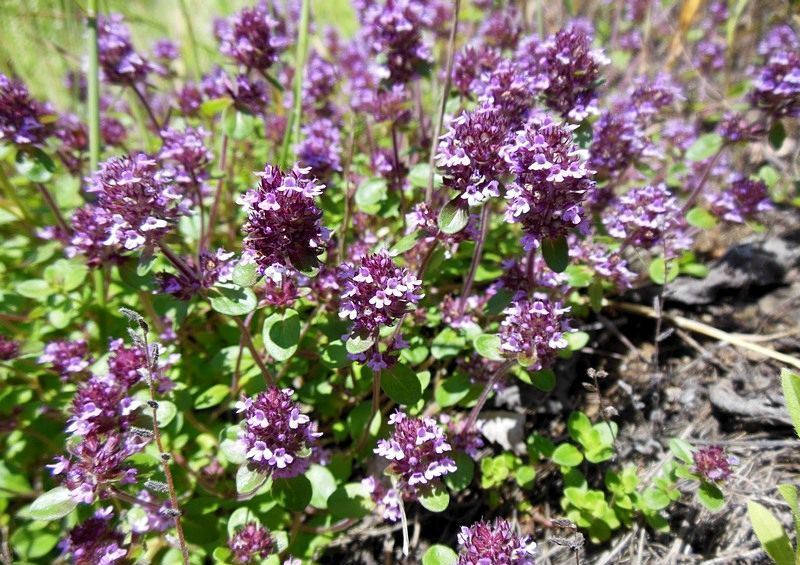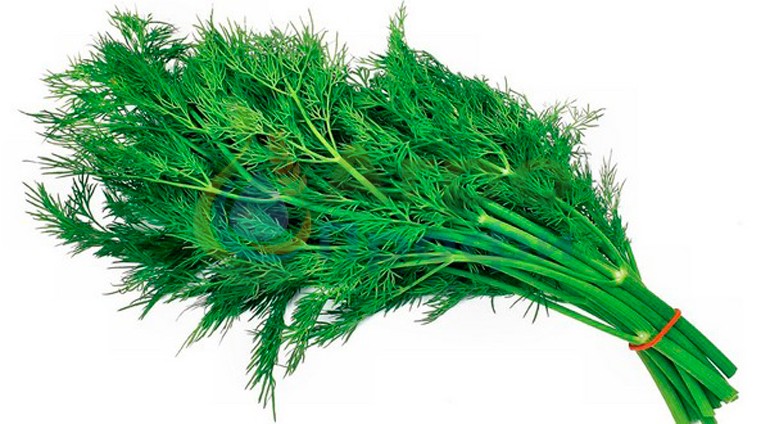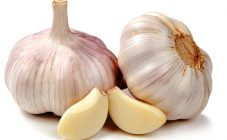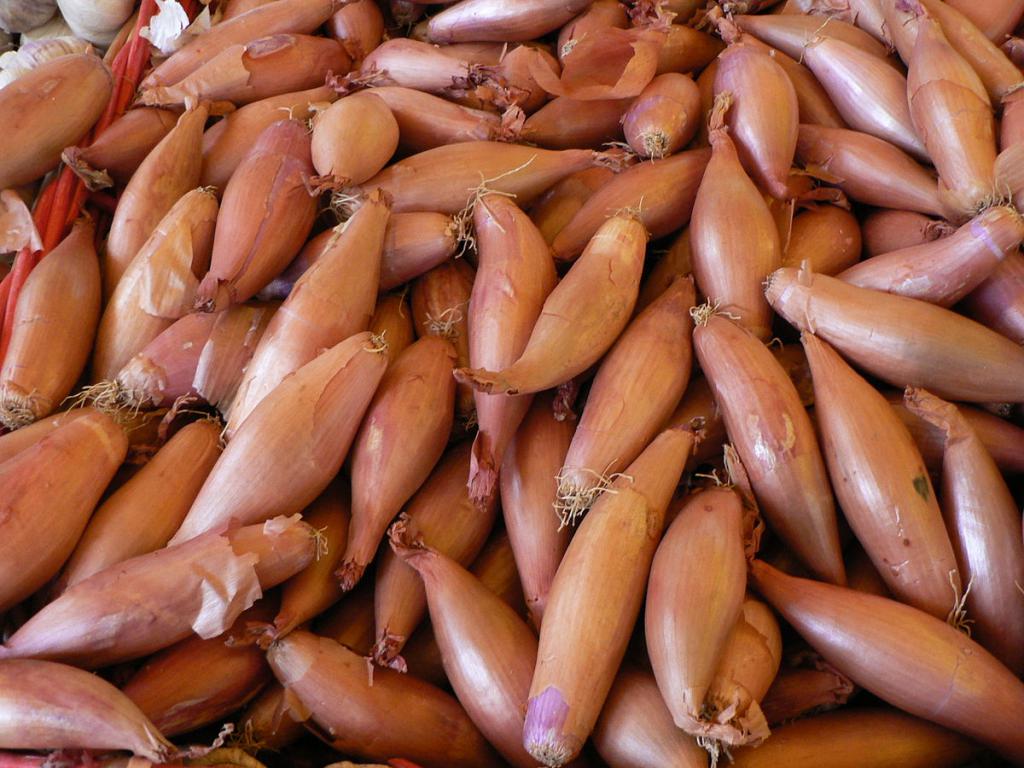Content:
This perennial plant has been popular since ancient times as a medicinal raw material for folk recipes. Creeping thyme has also found its place in kitchens as a spicy seasoning. Therefore, the grass lives not only in the wild - lovers of aromatic tea grow it in their summer cottages.
Description
Creeping clumps can be found everywhere, but usually the plant covers the dry sunny slopes and hills of the European part of the country. It takes root well on depleted soils, sandy and even rocky.
Thyme is a small shrub. The lignified creeping stem has no leaves, tetrahedral branches rise up from it, growing on average up to 15 cm. Shoots are covered with half-pressed hairs and are covered with small oblong elliptical leaves on short petioles. The plates themselves are bare, and bas-relief veins can be seen on the underside.
Small flowers are collected in capitate inflorescences, which in the wild are painted pink with a purple tint. In varieties bred by breeders, the flower may have a different color. The plant produces a fruit, in the shell of which 4 brown seeds are hidden - spherical nuts.
Thyme "rugs" begin to bloom in June and delight with their beauty until August. The plant is very fragrant, and each part of the bush exudes a pleasant aroma.
Varieties
Common and creeping thyme species are most common in nature. It is with the second that confusion always arises - ignorant people associate thyme with caraway, although these are completely two different plants with spicy properties.
In fact, the thyme is called creeping thyme, which is also referred to as the Bogorodskaya herb. Confirmation of this is Latin - the botanical version of all three names is the same (thymus serpyllum).
Whoever appreciated the usefulness and decorativeness of thyme breeds it in their summer cottages, sowing thyme balls in open ground. Although seedlings will provide a faster crop cultivation, which can even decorate balconies.
To prepare medicinal Bogorodsky tea, wild creeping thyme is also quite suitable. For a variety of garden landscape, it is better to use different colors. The iridescent cover on the site will provide beautiful fragrant flowers th mu.
Popular varieties of creeping thyme
| Red carpet | An evergreen shrub with leafy stems, up to 10 cm high. Spicy emerald-green leaves during the flowering period are completely hidden under the "head" of bright pink inflorescences. | It belongs to the early varieties. A fairly winter-hardy plant, tolerates drought and shade well, is not susceptible to disease; Looks great in rockeries, flower beds and borders. It is used as a spicy and medicinal herb. |
|---|---|---|
| Nectar | A creeping shrub, 25 cm high, completely covered with ovoid-oblong small leaves. Flowers, pleasantly smelling of honey, have a delicate pink tint. | Extended vegetation - up to 150 days. Seedlings are planted in May, the seeds are sown before winter or early spring; Thyme is good in tea and as a dressing for various dishes. It has medicinal and decorative purposes. |
| Minor | A dwarf plant with pale purple flowers and small rounded leaves. Gives a lush, tall, beautiful "pillow" that completely covers the area. | The variety is old - bred almost a century ago. It is used in spices and for medicinal purposes. |
| Herba barona lois | Herbaceous perennial, sometimes grows up to 20 cm in length. Lanceolate leaves, at least 0.5 cm wide, have a pointed tip, and are covered with villi along the edge. The capitate loose oblong inflorescences are painted in a mauve shade. | It has no vegetative shoots, propagates only by seeds; By the aroma, the leaves resemble the smell of caraway. |
| Magic carpet | It covers not only horizontal rocky surfaces with a solid green carpet, but also grows well vertically. Fragrant flowers of various shades (from white to purple) are an excellent decoration for the garden. The leaves have a pleasant lemon scent. | The plant, resistant to frost and drought, is not demanding on the soil, but prefers closed areas; Propagated by seed and is often used in folk recipes. |
If desired, in nurseries, you can find seedlings and other varieties of thyme serp llum. Any of them will turn out to be a profitable 3-in-1 purchase.
Culture properties
It is difficult to describe in the article all the healing properties of Bogorodskaya grass - such is the wide range of effects of thyme on diseases. The beneficial composition of the plant provides this:
- organic acids;
- tannins;
- a large set of vitamins, where group B and ascorbic acid are allocated;
- flavonoids and resins;
- gum and carotene.
Folk medicinal composition is used for bronchitis and severe cough. Eliminate stomach pains with thyme and increase acidity. Aromatherapy with thyme has long been used in the treatment of nervous diseases and insomnia.
The broth cleanses the kidneys and stops uterine bleeding. Alternative therapy can help men cope with prostatitis and improve sperm quality. When applied externally, tinctures help in the fight against radiculitis and rheumatic pains.
Herbaceous dwarf shrub and traditional medicine were not ignored. Doctors recommend to patients decoction of thyme for acute respiratory infections and diseases of the respiratory tract, as an anesthetic for neuralgia and radiculitis. Fragrant baths and compresses with herbal extracts are especially useful.
Each healing characteristic suggests that thyme could be called a panacea, if not for the harm that the plant can bring in some cases.
Contraindications
- with caution, drugs with thyme should be taken for hypertensive patients and heart patients, and with cardio and atherosclerosis, ciliated grass arrhythmias is contraindicated in general;
- because of thymol, which is part of the composition, it is impossible to take funds for people with a diseased liver;
- diuretic properties can be harmful in a number of kidney diseases;
- the contraindication also applies to gastric problems with high acidity;
- you should not get carried away with Bogorodsky teas for those who have problems with the thyroid gland;
- it is advisable to give up thyme for a while and for pregnant women.
About pests
Despite the fact that creeping thyme grows well in the wild, in garden plantings, the plant should be provided with decent care. One of the points of agricultural technology is protection against diseases and pests.
Due to its antiseptic properties, thyme is relatively resistant to diseases - it is partially affected only by fungi. But some pests are attracted by essential oils. Insects are not averse to feasting on the spicy taste of Bogorodskaya grass.
The main pests of thyme
| Red carpet | Evergreen shrub with leafy stems, up to 10 cm high.Spicy emerald-green leaves during the flowering period are completely hidden under the "head" of bright pink inflorescences. | It belongs to the early varieties. A fairly winter-hardy plant, tolerates drought and shade well, is not susceptible to disease; Looks great in rockeries, flower beds and borders. It is used as a spicy and medicinal herb. |
|---|---|---|
| Nectar | A creeping shrub, 25 cm high, completely covered with ovoid-oblong small leaves. Flowers, pleasantly smelling of honey, have a delicate pink tint. | Extended vegetation - up to 150 days. Seedlings are planted in May, the seeds are sown before winter or early spring; Thyme is good in tea and as a dressing for various dishes. It has medicinal and decorative purposes. |
| Minor | A dwarf plant with pale purple flowers and small rounded leaves. Gives a lush, tall, beautiful "pillow" that completely covers the area. | The variety is old - bred almost a century ago. It is used in spices and for medicinal purposes. |
| Herba barona lois | Herbaceous perennial, sometimes grows up to 20 cm in length. Lanceolate leaves, at least 0.5 cm wide, have a pointed tip, and are covered with villi along the edge. The capitate loose oblong inflorescences are painted in a mauve shade. | It has no vegetative shoots, propagates only by seeds; By the aroma, the leaves resemble the smell of caraway. |
| Magic carpet | It covers not only horizontal rocky surfaces with a solid green carpet, but also grows well vertically. Fragrant flowers of various shades (from white to purple) are an excellent decoration for the garden. The leaves have a pleasant lemon scent. | The plant, resistant to frost and drought, is not demanding on the soil, but prefers closed areas; Propagated by seed and is often used in folk recipes. |
| Meadow moth | Caterpillars eat the bottom plate of the leaf, then move to stems and flowers. The appearance of the pest can be judged by the cobwebs that have appeared on the bush. | To avoid the invasion of a moth, in the fall they do a digging of the site; Preventive measure - timely removal of weeds; The appeared pest is destroyed by Decis. |
| Sandy slow | A black beetle measuring no more than 10 mm in a short time is capable of destroying the entire ground part of the bush. | Remove the pest with pesticides; You can use fragrant baits (as a distraction). |
| Aphid | Despite the fact that this is a very small pest, the damage from it is significant, since the insect does not appear in individual individuals. In the blink of an eye, the plant is covered with a colony of unpleasant-looking light green insects. Insects bite through young stems and leaves and suck the juice out of them. | The most effective in this case are Antitlin and Biotlin. |
| Weevil | The small bug got its name from the elongated proboscis on the elongated head. With its help, the insect damages leaves and flowers. Likes to lay larvae in buds. | For preventive purposes, plants are periodically treated with Fitoverm. The same drug effectively copes with insects that have appeared on the site. |
If the rules of agricultural technology are violated, thyme loses its immune properties and begins to hurt. At this time, the culture is especially susceptible to pest infestation. Drugs such as Topaz, Fundazol, Horus, Ridomir will help fight infection. But the main thing is to ensure proper watering and access to sunlight. Then the rainbow carpet of rockery will scent all season, filling the site with a heady spicy aroma.















